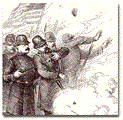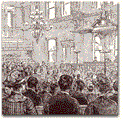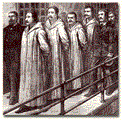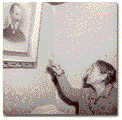Introduction
Welcome to The Dramas of Haymarket, an online project produced by the Chicago Historical Society and Northwestern University. The Dramas of Haymarket examines selected materials from the Chicago Historical Society's Haymarket Affair Digital Collection, an electronic archive of CHS's extraordinary Haymarket holdings. The Dramas of Haymarket interprets these materials and places them in historical context, drawing on many other items from the Historical Society's extensive resources.
A fuller description of the site and a discussion of its conceptual dimensions follow below. If you wish to proceed directly to the site's contents, however, click on the Main Contents link on the left side of this page. It may be helpful first to read the How to Navigate and Technical Support pages. The Credits page lists people responsible for this site. Resources will take you to a Site Map, a Guide to Further Reading, and downloadable PDF Files of selected pages. Archive is the link to the Haymarket Affair Digital Collection.
Structure of the Site
The Dramas of Haymarket itself is organized in the form of a drama, a tragedy in five Acts with a Prologue and an Epilogue. The seven major parts of the site–the Prologue, the five Acts, and the Epilogue–are arranged chronologically. While the site devotes considerable attention to the Haymarket protest meeting on the evening of May 4, 1886, at which several policemen were killed by a dynamite bomb attributed to political radicals, it encompasses a great deal more.
The Prologue is titled "Whither America?"
and deals with the period between the Great Chicago Fire of 1871 and around
1880, devoting considerable attention to the importance of the national
railroad strike of 1877 and other developments in the radicalization of
many American workers. Act I, "Subterranean Fire," traces the widening
class divisions in American society and  the
rising level of violence in word and deed from the early 1880s to the
time of the Haymarket meeting. Act II, "Let Your Tragedy Be Enacted Here,"
focuses on the meeting itself, though it first discusses the national
eight-hour demonstrations of May 1 1886, that centered in Chicago. Act
III, "Toils of the Law," is the largest Act. It covers the legal proceedings
that began with the "red scare" and police "witch hunt" immediately following
the bombing and extended through the sentencing of the convicted anarchists
in October 1886. Act IV, "The Voice of the People," examines the legal
and public appeals that ended with the executions in November 1887; Act
V, "Raising the Dead," opens with the funeral of the executed men and
concludes with Illinois Governor John Peter Altgeld's absolute pardon
of the surviving defendants in 1893. The Epilogue, which is titled "Drama
without End," surveys the contested heritage of Haymarket up to the present,
including centennial events in Chicago in 1986.
the
rising level of violence in word and deed from the early 1880s to the
time of the Haymarket meeting. Act II, "Let Your Tragedy Be Enacted Here,"
focuses on the meeting itself, though it first discusses the national
eight-hour demonstrations of May 1 1886, that centered in Chicago. Act
III, "Toils of the Law," is the largest Act. It covers the legal proceedings
that began with the "red scare" and police "witch hunt" immediately following
the bombing and extended through the sentencing of the convicted anarchists
in October 1886. Act IV, "The Voice of the People," examines the legal
and public appeals that ended with the executions in November 1887; Act
V, "Raising the Dead," opens with the funeral of the executed men and
concludes with Illinois Governor John Peter Altgeld's absolute pardon
of the surviving defendants in 1893. The Epilogue, which is titled "Drama
without End," surveys the contested heritage of Haymarket up to the present,
including centennial events in Chicago in 1986.
Each of the seven parts consists of an interpretive essay and either three or four topical sections including visual materials, artifacts, documents, manuscripts, and many kinds of printed texts. All of these entries are extensively described and analyzed. The Prologue and Acts I through V also contain a final section called "From the Archive," which features the complete text of selections from the Haymarket Affair Digital Collection. (Please note that the transcriptions are meant to be faithful to the sources from which they are taken, and that they therefore may contain errors and inconsistencies.) Instead of a "From the Archive" section, the Epilogue's "Personal Recollections" section offers the reflections of several individuals who provide a living connection to the heritage of Haymarket. These include author Studs Terkel, Illinois Labor History Society President Les Orear, and descendants of both a police officer severely injured by the bomb and of one of the anarchists convicted at the trial. The Dramas of Haymarket and the Haymarket Affair Digital Collection are linked, so that the browser will be able to move easily from one of these paired sites to the other.
The Dramas of Haymarket has numerous other special features, notably virtual tours of the Haymarket area and of Forest Home cemetery, where the monument to the convicted men, now a National Historic Landmark, is located. The tours provide a sense of these places as they were in the late-nineteenth century and as they have changed over time. The browser can also listen to several labor songs.
Most importantly, however, The Dramas of Haymarket fully employs the multimedia and hyperlinking capabilities of the Internet to present an enormous array of primary sources on dynamic display. The site thus attempts to provide the kind of texture for which the web is especially well-suited, accompanied by an interpretive text that explains these materials in depth. This interpretive text is informed by the considerable body of scholarship on Haymarket.
Understanding Haymarket
The Haymarket meeting and bombing, the
subsequent riot, arrests, trial, and executions, and related events of
the period form one of the most remarkable episodes in the history of
Chicago, the United States, and of working people everywhere. On the evening
of May 4, 1886, a few thousand people assembled in the Haymarket area at the intersection of Randolph and Desplaines Streets,
across the South Branch of the Chicago River about eight blocks west of
City Hall. The purpose of the rally was to protest the killing of two
workers the previous day by the police when they broke up an angry confrontation
between locked-out union members and their replacements at the McCormick
reaper factory on the city's Southwest Side. This confrontation was one
of many outbreaks of violence at the time due to labor and class tensions.
Central among labor's demands was the eight-hour workday.
Haymarket area at the intersection of Randolph and Desplaines Streets,
across the South Branch of the Chicago River about eight blocks west of
City Hall. The purpose of the rally was to protest the killing of two
workers the previous day by the police when they broke up an angry confrontation
between locked-out union members and their replacements at the McCormick
reaper factory on the city's Southwest Side. This confrontation was one
of many outbreaks of violence at the time due to labor and class tensions.
Central among labor's demands was the eight-hour workday.
As the protest meeting in the Haymarket was nearing a close, about 180 police marched from the nearby Desplaines Street station to the makeshift speakers' stand. Immediately after a police commander ordered the rally to disperse, someone threw a dynamite bomb into the ranks of the officers. One officer was killed almost instantly, and six more would die in the next few days and weeks of wounds either caused by the bomb or sustained in the riot that followed. Acting with overwhelming public support, the police arrested dozens of political radicals. In the trial that followed, eight anarchists were found guilty of murder. After appeals to the Illinois and United States Supreme Courts failed, four of the defendants were executed on November 11, 1887. One day before the hangings, another defendant committed suicide. Illinois Governor Richard Oglesby commuted the capital sentence of two other defendants to life in prison. The jury had sentenced the eighth defendant to fifteen years at hard labor.
Scholars have long considered the Haymarket trial one of the most notorious miscarriages of law in American history. At this time of cultural crisis, the defendants were convicted by a prejudiced judge and jury because of their political views, rather than on the basis of solid evidence that linked them to the bombing. Although most middle-class Americans and even many working people at the time cheered this action and praised the police as defenders of public order, the executions transformed the anarchists into martyrs of labor in this country and throughout the world. The cultural memory of Haymarket has echoed ever since through many other events.
The Chicago Historical Society owns a wealth of Haymarket materials, hundreds of which are on display here. These include a wide variety of artifacts, from the baton carried by the officer who ordered the rally dispersed to a tiny lapel pin in the shape of a gallows worn by those who protested the verdict. In addition, CHS's Haymarket holdings contain numerous transcriptions and manuscripts–among them the complete trial testimony and autobiographies prepared in prison by two of the defendants–and hundreds of photographs, engravings, books, pamphlets, periodicals, newspapers, and other publications. Despite the strong enduring interest in Haymarket, many of these materials have been seen only by a relatively small number of researchers who have visited the Society's Research Center. Now that a substantial portion of CHS's Haymarket holdings are online, they will be viewable at any time of day from anywhere in the wired world.
Dimensions of the Drama
The Dramas of Haymarket provides a context and a structure for examining and understanding these materials. The site takes its title and its organizing idea from the multiple ways in which the elements of Haymarket present themselves as drama. The nature of the place and time in which Haymarket unfolded was inherently dramatic. In the decades following the Civil War, Chicago epitomized the new industrial city in America's major era of urbanization. During the 1880s, Chicago's population exploded from a half million to over one million people, and the city experienced the turmoil associated with such rapid growth and change, a troubled economy, and a constant influx of newcomers from Europe and other parts of the United States.
Like other industrial cities, Chicago
in this period witnessed countless rallies, demonstrations, parades, and
the like, many of them carefully staged. The Haymarket meeting was only
one of such "scenes," though the bomb was the most spectacular  occurrence
at any of them. These events were often highly organized occasions meant
to dramatize a certain group's presence or the power of particular ideas
in a time when the proper direction of the nation was being passionately
debated and the future appeared uncertain. One element that added to the
drama–and the Haymarket bomb is the best example and symbol of this
element–was the unpredictability of such events, especially the way
they could suddenly turn deadly serious.
occurrence
at any of them. These events were often highly organized occasions meant
to dramatize a certain group's presence or the power of particular ideas
in a time when the proper direction of the nation was being passionately
debated and the future appeared uncertain. One element that added to the
drama–and the Haymarket bomb is the best example and symbol of this
element–was the unpredictability of such events, especially the way
they could suddenly turn deadly serious.
The idea of drama also extends to the particular structure of the formal aspects of Haymarket, notably the legal proceedings. The indictment, trial, appeals, and the meticulously orchestrated execution on the scaffold in the Cook County Jail all either followed or, as in the trial transcription, took the form of a script. The language of the law required participants in the case to speak in stylized ways, and the trial cast the various figures into certain roles, turning some people into jurors, others into defendants, witnesses, and the like. In making their cases in court, both the prosecution and the defense offered opposing dramatic narratives that explained the events in contrasting ways, one side portraying the defendants as villains, the other as innocent victims. Legal practices dictated to all involved how they must speak and act in the courtroom, the stage on which the nation's attention was riveted during the summer of 1886. The highly ritualized dramas continued even after the executions, in the funerals, the unveiling of monuments honoring both the police and the anarchists, and the many ceremonies of memory held at these monuments ever since.
Many of the principals in Haymarket had what can be described as a dramatic sensibility. Some of the men forced to stand trial eagerly embraced the cultural spotlight in which the trial had placed them, while the judge, the attorneys on both sides, and the police self-consciously "performed" for the public. And both the supporters of the defendants and the world at large understood Haymarket as drama and tragedy. In her description of her husband Albert on the gallows, Lucy Parsons wrote, "No tragedian that has paced a stage in America ever made a more marvelous presentation of a self-chosen part, perfect in every detail." A popular magazine described the same scene as "The Last Act" in "Chicago's tragedy of bombs and blood." Under an engraving of a jailer adjusting the noose on the neck of one of the condemned men, an editor added the caption, "Ring down the curtain." A New Orleans newspaper called Haymarket "a drama attended by saturnalian lights and scenes," and went on to divide its key episodes into four acts. Four years later, a critic of the verdict described Haymarket at length as an epic tragedy in three acts, the final one yet to come, when the masses would rise up against their murderous oppressors.
And, of course, so many of the particulars
of Haymarket were unquestionably dramatic. Albert Parsons, who had escaped
arrest, turned himself in on the first day of the trial. Parsons, who
could trace his ancestry back to Puritan New England, had fought for the
Confederacy in the Civil War and afterwards married an African American
woman before moving to Chicago. The mayor of Chicago attended the meeting
at which the bomb was thrown and testified at the trial–as a witness
for the defense. A proper young middle-class Chicago woman fell in love with defendant
August Spies and married him by proxy while he was on death row. Another
condemned man, Louis Lingg, somehow hid bombs in his cell and, the day
before his scheduled execution, killed himself by putting a blasting cap
in his mouth and lighting it. More than eighty years after the meeting,
a monument to the officers who marched on the meeting was blown up–twice–evidently
by radicals protesting the Vietnam War and racial discrimination. And
at the heart of all of these and many other aspects of the history of
Haymarket was this crude but appallingly effective bomb, thrown by an
unknown assailant into the ranks of the police on a chilly spring evening
in 1886, the explosion reverberating ever since.
A proper young middle-class Chicago woman fell in love with defendant
August Spies and married him by proxy while he was on death row. Another
condemned man, Louis Lingg, somehow hid bombs in his cell and, the day
before his scheduled execution, killed himself by putting a blasting cap
in his mouth and lighting it. More than eighty years after the meeting,
a monument to the officers who marched on the meeting was blown up–twice–evidently
by radicals protesting the Vietnam War and racial discrimination. And
at the heart of all of these and many other aspects of the history of
Haymarket was this crude but appallingly effective bomb, thrown by an
unknown assailant into the ranks of the police on a chilly spring evening
in 1886, the explosion reverberating ever since.
Although viewing Haymarket as drama helps to both organize and interpret the contents of the Haymarket Affair Digital Collection as a whole, it has certain limitations and liabilities. This approach may leave out or neglect important dimensions in the history of Haymarket and of the times of which it is a part that are not dramatic, while emphasizing in a potentially misleading way those dimensions that are the most sensational. More important, to talk about Haymarket as drama, theater, or spectacle may also seem to risk trivializing it by treating the deeply felt conflict, violence, passion, and suffering of which it consists as mere cultural performance.
This risk is genuine, but the hope underlying The Dramas of Haymarket is that its approach will convey above all a serious and complex understanding of the events it examines. The central subject of this site is not the spectacle of crime and punishment, or the melodrama of vengeance and redemption, but the quest for social justice. At the time of the bombing, the nature of America and the proper direction of its future were very much matters of contention. The Haymarket meeting was called in the first place to protest not only a specific act by the police but also against the whole basis of industrial society, and to declare how it might be changed for the better. The trial that followed makes very little sense as a legal proceeding, but can be understood as an attempt to reinforce and justify the current order, even if the law had to be bent in order to accomplish this.
Everyone involved was ultimately debating fundamental social questions. What rights and responsibilities does the ownership of property entail? How many hours must a person have to work in order to live decently, and how can he or she be assured fair compensation? What is the best way to constitute a truly open and democratic society that values the individual? Uniting these and related issues is one of the profoundest questions of all: under what conditions should human beings live and labor with one another? Until that question is answered, Haymarket will remain a drama without end.
Carl Smith, Curator